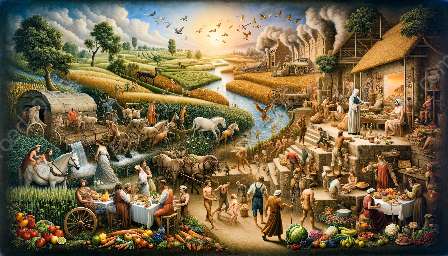Understanding the agricultural practices of ancient civilizations such as Mesopotamia, Egypt, China, and the Indus Valley provides valuable insight into the historical developments of food production and agriculture. The agricultural techniques and food cultures of these ancient societies have had a lasting impact on human history and continue to shape our food systems today.
Mesopotamia
Mesopotamia, often referred to as the cradle of civilization, was one of the earliest centers of agriculture. The fertile land between the Tigris and Euphrates rivers allowed for the growth of various crops, including barley, wheat, and various vegetables. The irrigation systems developed by the Sumerians and Babylonians were revolutionary for their time, enabling the cultivation of the land and contributing to the establishment of permanent settlements.
Egypt
The ancient Egyptians relied heavily on the annual flooding of the Nile for their agricultural practices. They developed sophisticated irrigation methods and were known for their meticulous record-keeping of agricultural activities. The cultivation of crops such as wheat, barley, and flax was essential for the sustenance of the Egyptian civilization.
China
In ancient China, agricultural practices centered around the cultivation of rice, a staple food that continues to be central to Chinese cuisine. The development of terrace farming and the intricate water management systems, such as the Dujiangyan irrigation system, allowed for the efficient use of land and water resources, contributing to the sustainability of Chinese agriculture.
Indus Valley
The agricultural practices of the Indus Valley civilization were characterized by the cultivation of wheat, barley, and various fruits and vegetables. The well-planned cities of the Indus Valley, such as Mohenjo-Daro and Harappa, exhibited a remarkable level of urban planning and advanced drainage systems, reflecting the significance of agriculture in sustaining the civilization.
Historical Developments in Food Production and Agriculture
The agricultural practices of ancient civilizations laid the foundation for significant historical developments in food production and agriculture. The innovations in irrigation, cultivation techniques, and crop selection pioneered by these civilizations have had a lasting impact on agricultural practices throughout history. The transition from simple farming methods to more sophisticated agricultural systems marked a critical turning point in human food production and enabled the sustenance of growing populations.
Food Culture and History
The link between food culture and history is evident in the agricultural practices of ancient civilizations. The cultivation of specific crops and the development of culinary traditions were intertwined with the societal, religious, and economic aspects of these civilizations. The exchange of agricultural knowledge and food products between different ancient societies also contributed to the evolution of food culture and the development of global food systems.
By understanding the agricultural practices of ancient civilizations and their impact on historical developments in food production and agriculture, we gain valuable insights into the interplay between food culture and history. These insights help us appreciate the rich tapestry of human agricultural heritage and the enduring influence of ancient agricultural practices on modern food systems.

